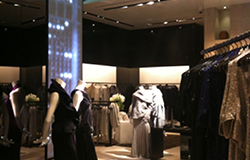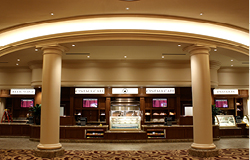Tunable White Light

Experimenting with color photography in the early to mid-19th century, artist Paul Outerbridge valued the role of light in color perception. What is color? he asked. No object of itself alone has color. We know that even the most brightly colored object, if taken into total darkness, loses its color. Therefore, if an object is dependent upon light for color, color must be a property of light.
This fundamental relationship between light and color is particularly relevant today given the technological advances that have enabled the unprecedented control of color temperature in solid-state lighting. Although early LED technology offered color-tuning capabilities, its color rendering index (CRI) was quite low so LEDs were typically used for color washing or signaling purposes. Over the past several years, however, the technology has advanced significantly. In lighting applications, in particular, manufacturers are achieving acceptable white light configurations with solid-state lighting (SSL). As a result, LED applications now offer a high-quality tunable white light with precise controllability.
Early white LED light was underwhelming due to limited combinations of blue LEDs and yellow phosphors. Today, new phosphor compounds and remote phosphors yield higher CRI. Color consistency among different manufacturers products, and even within each manufacturer's own bin groups, has been a challenge. This has necessitated the development of advanced drivers that offer firmware compensation the ability to compensate for individual color temperature variations due to binning discrepancies. Real-time feedback systems installed in lamps have also helped to minimize color shifting in LEDs when they are dimmed. Although new materials, drivers, and hardware enable unprecedented consistency in color temperature and intensity, lighting manufacturers must also ensure that the associated software and hardware continue to perform over the life of the LED system and within the desired range of output.
Tunable white light is a technology that enables users to adjust the color temperature of a lamp in real time. For LEDs, users modify the correlated color temperature (CCT) and intensity of the source with an input, such as a slider control or intelligent lighting management system. The range of attainable color temperatures varies by product: a typical range may lie somewhere between 1600K and 6500K. Nevertheless, most recent manufacturer offerings provide a tunable spectrum with an effective range that covers both warm and cool temperatures.
Although tunable white light may seem a logical perhaps even expected capability of lamps and fixtures, it is worth taking a brief visit back through the history of lighting to comprehend how remarkable it is. Initially, the principles of white light and its relationship to color were not well understood. Isaac Newton's prism experiments, conducted from 1666 to 1672, revealed that light alone is responsible for color. Until that point, however, white light was a complete mystery.
The invention of electric light in the early 1800s led to the desire to deliver it at precise color temperatures. The scientists, engineers, and researchers who developed incandescent lighting recognized that different filament materials produced different temperatures of light. And by the mid-20th century, CRI became a metric for measuring how well a light source shows color naturally with incandescent lamps approaching blackbodies at the top of the scale, high pressure sodium lamps at the bottom, and fluorescent lamps in between.
SSL offers a level of control that allows users a higher degree of finesse when it comes to light output. The realization of tunable white light requires the capability to tune a source's color temperature in real-time and with satisfying CRI results. Achieving this meant that SSL manufacturers had to develop both mixable LED modules and sophisticated software in order to maintain a balanced output relative to the blackbody locus, or the tunability within a perceptibly uniform color space.
A tunable white light LED system comprises the general components: a rectifier to convert AC voltage to DC, a master controller to regulate the system, LED fixtures that serve as slaves, and communication interfaces commonly DMX or DALI that deliver the instructions. The master controller either requests the desired luminous output from each fixture or it must calculate and communicate the expected CCT to each LED driver independently. The master controller also runs the firmware that governs color-mixing algorithms, which compensate for color temperature and binning irregularities. The fixtures typically possess different channels of cool, neutral, and warm white diodes that are mixed within each integrated device to achieve the desired CCT.
In tunable white LED light, a user's desire for a warmer or cooler color temperature means that the lighting software has to adjust the drive current for each channel, which in turn changes the intensity of each LED within a module. This adjustment is made in a way that warm-white and cool-white LEDs are mixed in a perceptually smooth manner, according to the blackbody locus. Although this may seem simple, it does require lighting manufacturers to overcome many technical challenges.
To look at one example of this, USAI Lighting president Bonnie Littman says that her company selects the LEDs and bin mix, as well as reviews thermal management and drive-current considerations, for its tunable white LEDs. To achieve fixture-to-fixture consistency in our tunable white Color Select product, she says, the LEDs we select and mix must maintain stable color when dimmed at all color temperature and brightness levels and combinations. USAI requires its LED products to maintain a minimum of a two-step MacAdam ellipse a region in the chromaticity diagram in which colors differences are imperceptible. As a result, color consistency between diodes falls within two steps, plus or minus 50K. (For more insight from Littman, read our interview with her here.)
In addition to the technology, the user interface is also critical. In developing its control interfaces, Littman says, USAI Lighting had to design both simple user interfaces that are familiar and comfortable, such as simple room-side dimming switches, and [interfaces that are] compatible with more complex and fully automated dimming systems. In order to attain such functionality, USAI Lighting and other manufacturers have developed their own proprietary and patented algorithms and circuitry to enable consistent control over complex color changes that are user friendly.
Tunable white light also offers enormous benefits for both users and the design team, says Jeff Spencer, director of commercial product management and market development for Juno Lighting Group. One challenge that almost all specifiers have encountered is completing a project and then having the end user say it feels too cool or feels too warm due to the color temperature of the light, he says. This is a judgment that can't be made properly until the fixtures have been installed and at that point, it is usually too late to change anything.
This is particularly important for project designs in which getting the desired color temperature is critical such as retail settings, museums, and certain kinds of healthcare environments. A warm or cool CCT can enhance or mute particular colors of merchandise, such as supermarket produce (making it appear fresh or stale) or jewelry (by illuminating their sparkle). Diamonds look best under cooler color temperatures, but jewelers now have a choice to set their lighting to warmer color temperatures to show certain metals or colored stones, Littman says. The design intent of a space also plays a large part, says Brian Stacy, Arup's lighting leader for the Americas. Tunable white light allows lighting consultants to adjust the white light in an all-white surface treatment application for a truly minimalist piece of architecture, he says.
Tunable white light also guards lighting designers against unforeseen circumstances in the design and construction process. A common problem is the disconnect between the planned and executed luminous program such as when an interior designer tells the lighting designer that they want a particular material and color palette, but later changes it to one that is no longer compatible with the specified lamp and color temperature. A cool color temperature may be specified for a black granite boardroom table, Spencer says, but if the interior designer changes his or her mind and goes with a dark wood, a warm color temperature may have been the more appropriate choice. In either case, a fixture with color tuning allows specifiers to change and adapt the delivered light color to enhance or complement the end result.
This technology can enhance a long-term maintenance strategy for LEDs. In a period of time when a few LED downlights need to be changed because of some failures, this tunable white feature takes the risk out of not being able to color match the light, Stacy says.
Perhaps the most important advantage of tunable white light is its ability to enhance the level of human experience. For one thing, when programmed to emulate the changing colors and intensities of the natural daylighting cycle, tunable white LEDs can improve occupant mental health and productivity. We know that students test best at 5000K but require cooler color temperatures of 6000K and higher when arriving at school to start their day, Littman says. In healthcare spaces, a tunable LED fixture could provide cool light for medical examinations and a more comfortable, warm light for the patient environment.
Examples like this hint at the broad significance that tunable white LEDs could have on the built environment, particularly as the technology evolves. Meanwhile, researchers, after many decades of study, now have enough information to make a legitimate scientific case about the influence of color temperature on human health and the effects of light on circadian rhythms. As our understanding of color temperature and its impact on our actions, moods, and performance expands, lighting will become personalized, Littman says. People's environments will tie into how they feel or want to feel and the specific tasks they are performing, ultimately impacting the way people live, work, and play.
Related Projects

Donna Karan Collection at City Center
Las Vegas, NV

K + L Gates
Pittsburgh, PA

Island Cinema - Fashion Island
Newport Beach, CA

|

|
Tweet |


